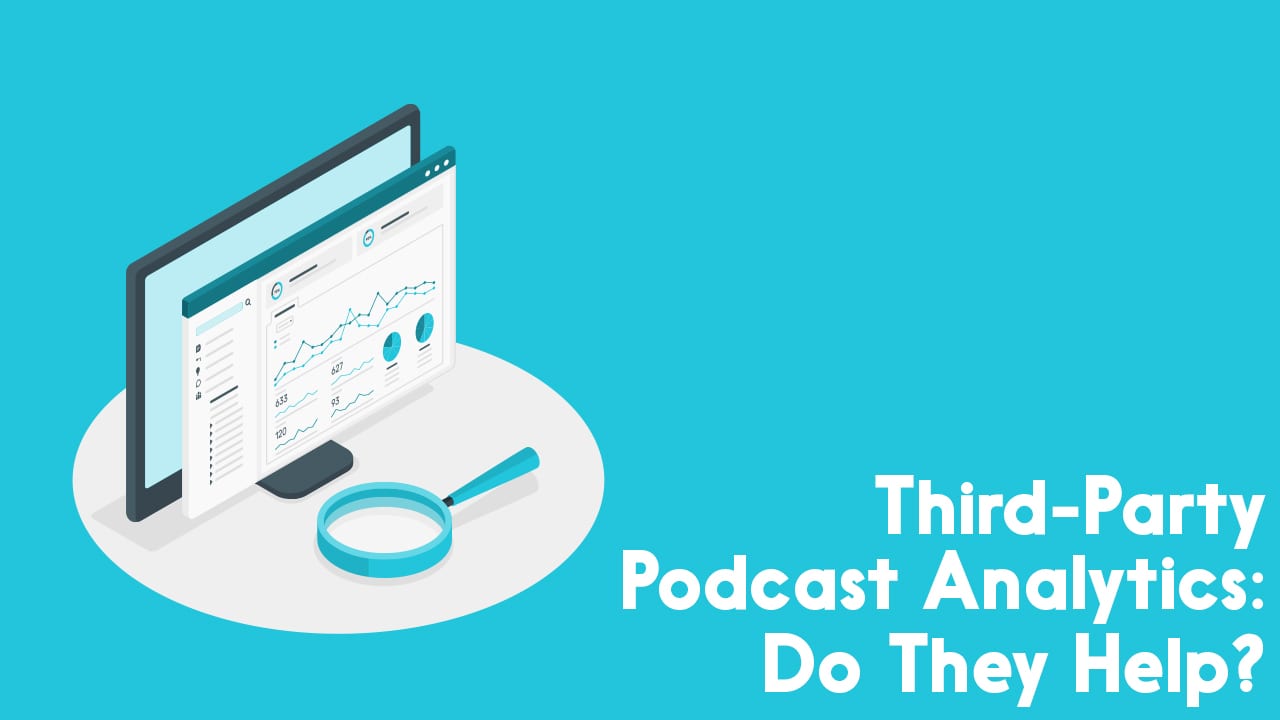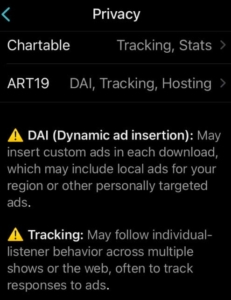Third-Party Podcast Analytics: Do They Help Your Growth?

You always want to know what impact your podcast has. Your podcast’s media host shows when, where, and how often your audience downloads your podcast. Spotify, Apple and Google all have dashboards for podcasters. These can show how your podcast’s downloads compares to others, (i.e., chart ranking), and Apple Podcasts can show you reviews, but only within your home country. A third party podcast analytics provider can show you ranking, stats and reviews globally. They can show reviews for multiple podcast directories. But, they can also cost money for a membership fee, and take time from producing tasks. How, exactly, are third-party podcast analytics services helpful?
Third-Party Podcast Analytics: The Pros
Knowing when, where, and how people download your podcast is good. It can give you statistics to give to sponsors. Let’s say you want to approach a bait and tackle business to sponsor your fly fishing podcast. If you know that your podcast gets 30 downloads a month in Arkansas, but it’s not downloaded at all in California, you know that it’s a better idea to approach bait and tackle shops in Arkansas than nationwide, or in California.
It can help you connect with your audience more meaningfully. If you’re planning to travel to conferences, and you know that your podcast has a lot of downloads in one region, but not so many in another, you can figure out how to budget your travel plans. It is worth mentioning that all good media hosts can give you thorough and accurate geographic stats, so be sure to check with them before signing up to any additional services for this aim alone.
Another aspect of these services is the compiling of listener reviews. Sharing reviews from around the world on social media and in your media kit never hurts. It makes your audience feel valued and it shows potential sponsors and press some objective, positive proof of your podcast’s impact.
Third-Party Podcast Analytics: The Cons
A concern here is privacy. You might make it abundantly clear to your audience that you won’t sell, rent or trade your email list, or any of your subscribers’ or customers’ private information. However, a third-party analytics provider can have its own ideas. It’s possible for them to collect data about your audience without your knowledge, and use it however they like, according to their own terms and conditions. As with any digital service, even if it’s free, it’s always worth it to read the fine print. For example, can your listener opt-out of any potential browsing or location tracking? If not, the service you’re using likely isn’t GDPR/CCPA compliant, and that’s going to be a problem.
Another potential downside is obsessive stats checking. How much time do you really need to spend hitting refresh on your download statistics page? When I first started podcasting, I probably checked my media host’s download stats once an hour. Libsyn should have created a special pop-up message that said, “Calm Down, Lindsay.” If you spend five minutes looking at your download stats, five times a day, that’s 25 minutes you could have spent scribbling out an outline for your next episode, or writing a thank you note to an interview guest.
Add that 25 minutes a day of checking your media host’s stats to time spent checking a third-party analytics site, and you start to wander into an ugly mental place. When you start obsessing over download and ranking numbers, you lose sight of meaning, Next thing you know, you’re writing word salad in your show notes to try and make your SEO look better, or repeating buzzwords in your episodes in a desperate attempt to keep your audience from tuning out.

How to Make Third-Party Podcast Analytics Work for You
Third-party podcast analytics providers compete with each other to make the most helpful product. This means, with a little restraint and some fine-tuning, you can make them help your podcast production process. You won’t have to sacrifice a ton of money, time, sanity, or show quality, either. Generally, third-party analytics providers don’t update their information more than once a day. There’s no point in checking more often than that. They also can email you information as a daily or weekly digest. If your stats aren’t changing drastically, and there’s no new reviews, you can just read the email, bin it, and get on with your day.
By the way, this article uses some affiliate links. if you purchase a membership through these links, we may earn a small commission, though this doesn’t affect your purchase price.
Let’s look at a few different third-party podcast analytics providers, and weigh the benefits.
My Podcast Reviews
MyPodcastReviews (like it says in the name) specializes in reviews, from Apple Podcasts, Stitcher, Podchaser and Castbox. You can get the information sent to you as a daily or weekly email alert.
A really useful feature they offer is Love The Podcast, which makes it easier to ask for reviews. It’s a simplified “lovemypodcast.com” URL to a mobile-friendly page that displays links to review your podcast, on the platform of the user’s choice.
The pricing varies by how many podcasts you want to track (for example, if you wanted to track all the podcasts in your network). They have a 14-day free trial.
- Small: $50/year, up to 2 podcasts
- Medium: $150/year, up to 7 podcasts
- Large: $250/year, up to 15 podcasts
Making it easy for people to review your show is the best way to get reviews. The fewer clicks the user has to do, the better.

Editor’s Note
In April of 2023, Chartable announced, “We are deprecating our Apple Podcasts integration on June 1, 2023 to ensure our customers enjoy a high-quality, seamless experience when using Chartable to understand and build their audience. As a result, creating or editing Apple Podcast connections will be unavailable beginning May 15, 2023.” Well, that was fun while it lasted.
Chartable
Chartable provides a daily email update, which shows global rankings and reviews from Apple, Spotify, and Stitcher. Users can connect their Chartable account to Apple Podcasts Connect and Spotify for Podcasters, to get more specific demographic data. These third-party podcast analytics can include information such as gender, age, and how long each episode is played.
Chartable’s standout feature is called SmartLinks. This means that you can share podcast links with trackable data, and automatically route listeners to your podcast in their favorite apps. This is good because you can compare how well or poorly your promotional channels perform.
Chartable’s pricing is determined by the number of downloads. They have a free tier.
- Hobbyist: This level is free, for podcasters with fewer than 20,000 downloads per month. It shows you up to 30 days of data history, emails you a daily stats update, and your account can have up to 5 users. Users get 5 SmartLinks a month.
- Indie: For $20 a month, podcasters with 100,000 downloads a month can view up to one year of data history, have their stats updated four times a day, and have up to 10 users on their account. SmartLinks are unlimited.
- Pro: At $100 per month, podcasters with over 500,000 monthly downloads have their stats updated hourly, can view an unlimited data history, and have an unlimited amount of logins to the same account. No limit on SmartLinks.
- Enterprise: The price is “contact us.” Your podcast’s stats are uploaded hourly, and you have unlimited access to all features.

In the interest of full disclosure, I use Chartable for my global third-party podcast analytics, at the free level. It’s nice to have an email show up in the afternoon that tells me “your podcast is #50 on the Drama chart for Apple Podcasts in the United Arab Emirates!” or Slovenia, or Nicaragua or something. It’s better than a snack. It’s like an emotional snack.
A word of warning, though. Certain Chartable features can trigger a privacy warning in popular podcast listening app Overcast. Be sure to check your settings if you’re dabbling with using them, and always respect your audience.
PodKite
PodKite shows rankings and reviews for Apple, Podchaser, and Stitcher, and charts for Apple and Google. Their email update is delivered weekly, and you can choose the day. If you want this to be your Friday afternoon ego boost, or you need it available in time for your Monday marketing meeting, it’s up to you.
Similarly to Chartable, PodKite offers Kitelinks. These help you compare different marketing channels, when you share different episodes on social media. Based on your pricing tier, those Kitelinks can provide a little data, or a lot.
Pricing is determined by how many podcasts you track, rather than the number of downloads.
- Free: One podcast gets 6 Kitelinks per month, tracking rankings on Apple Podcasts and Google, ability to view 30 days of data, reviews and ratings on Apple Podcasts, Podchaser and Stitcher, across all countries.
- Starter: For $7/month, one podcast gets 30 Kitelinks per month. These Kitelinks have buttons to collect email newsletter signups, user reviews and ratings. You also get to track rankings, reviews and ratings on Apple Podcasts, Google, Podchaser and Stitcher, across all countries, with no limit to the time period.
- Growth: At the $19/month level, you get all of the above, plus you can track search terms and search term competitors. Kitelinks are unlimited.
- Pro: “contact us for pricing” – Unlimited features, plus custom domains, reports and integrations.
The buttons to collect email newsletter signups, user reviews and ratings are really useful. Usually, you’ll see these in website podcast players. They can be great for social media.
PodRover
PodRover collects reviews from Apple Podcasts and Stitcher. They can send you the reviews via an email digest, through Slack, and/or through a push notification system. Reviews can be organized by country, date, and rating.
PodRover puts a lot of effort into helping you promote your podcast. You can embed their widget into your podcast’s website, to show your latest reviews, and customize how many to show at a time. Podrover’s image cards are arresting pieces of visual media which show the review, your podcast’s logo, and a little tiny PodRover logo.
PodRover’s standout feature is that it will automatically publish reviews to your social media account for you. I’d have to have a lot of self-confidence and very little ego to use this feature, but it’s definitely a time-saver.
Podriver’s pricing falls into four tiers. if you only need to track one podcast, it costs $30/year. Otherwise, the breakdown is as follows:
- Pluto lets you track three podcasts a year for $5 a month.
- Saturn lets you track 12 podcasts for $15 per month.
- Jupiter allows you to track up to 20 podcasts for $30 a month.
An annual subscription saves you 17%. No matter which tier you choose, the features are the same. The only variance is the number of podcasts that you track.

What’s really going to help your podcast growth?
You definitely should keep track of your podcast reviews, so that you can see how your podcast has changed over time. Third-party podcast analytics providers can show you how audiences feel about your show, globally. They can show which episodes have the most impact. This can give you the confidence to take bigger risks as a podcaster. Would you try harder to get a particular guest if you knew you could see the impact of the episode? Even if your download numbers are small, the validation of humans listening, around the world, is a big confidence boost. Even when you get a negative review, you know people are listening.
However, you can spend too much time analyzing your rankings and chart position, instead of concentrating on making a good podcast. Just because celebrity podcasts will consistently top the Apple Podcast charts, it doesn’t mean you have to try to hire Rami Malek.
Third-party podcast providers’ services can become expensive over the long haul, too. You may want to invest the money you’d spend tracing search term competitors on something which actually will improve your podcast, like a new microphone or better software. But, some of these providers include promotion tools, like the image cards and engagement buttons.
Third-party podcast analytics providers can put some wind in your sails, but don’t overdo it.
Why I Value Third-Party Podcast Analytics
The first time I had a review sent to me by My Podcast Reviews, I was overjoyed. The review came in from Apple Podcasts Germany. It felt like getting a postcard from a magical land. Yes, I know Germany is real. At the time, I was doing data entry in a beige cubicle farm, and it was hard to believe that anything mattered. The review was thoughtful, specific, and positive. I was so happy, I screenshot the review and posted it on social media. The reviewer kindly revealed themselves. It was from Kessi Riliniki, who knows more about podcasting than I do, and is a very kind person. Kessi and I ended up working together on podcasts, and we’re still friends.
But, don’t spend a ton of money to hit refresh on your stats all day, like it’s your job. Use third-party podcast analytics in moderation, to listen to your audience, promote your show, and stay motivated.
Need More Help?
If motivation and promotion aren’t your problem, but technology is, we can help. Alitu is the all-in-one podcast maker that removes tech stress and streamlines your editing process. If you want to learn more about recording, editing, promotion, or any other aspect of podcasting, have a look at Podcraft Academy. We have video and audio courses, downloadable resources, and weekly live Q&As to support you taking the next steps to podcasting success.
